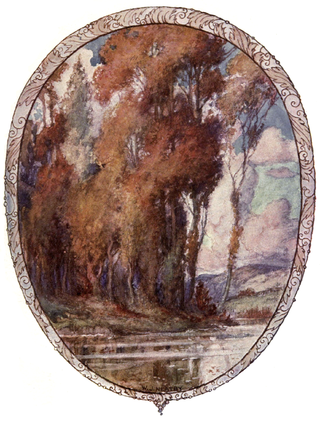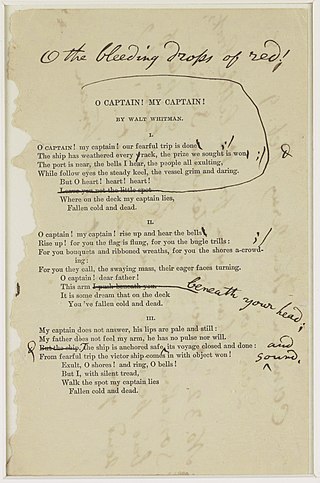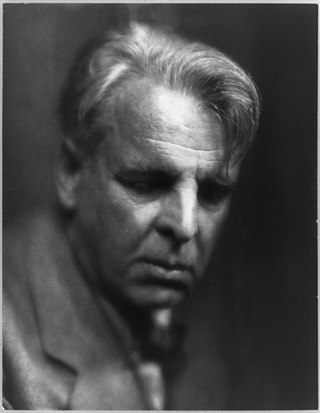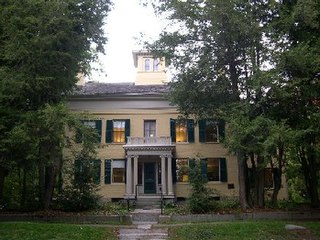
"I like to see it lap the Miles" is a short poem by Emily Dickinson describing an "iron horse" or railroad engine and its train. The poem was first published in 1891.

"I like to see it lap the Miles" is a short poem by Emily Dickinson describing an "iron horse" or railroad engine and its train. The poem was first published in 1891.
This poem is four stanzas, each with a length of four lines, and describes a railroad engine and its train of cars in metaphors that suggest an animal that is both "docile" and "omnipotent". The train "laps the miles" and "licks up the valleys" then stops to "feed itself" at tanks along the way. It passes mountains with a "prodigious step", "peers" superciliously into shanties, and moves through a narrow passage in a quarry. After descending a hill, it stops at the terminal like a horse before its barn door. It is also known as "The Amherst Train" or "The Railway Train".
| Close transcription [1] | First published version [2] |
|---|---|
| THE RAILWAY TRAIN |

Helen Vendler points out that the railroad (as a symbol of progress) was not an uncommon subject for literature in 19th century America, and indicates Dickinson's father (a lawyer) was instrumental in bringing the railroad to their hometown of Amherst, Massachusetts. [3] The station was situated not far from the Dickinson Homestead on Main Street, and the reclusive Dickinson attended its opening, watching alone from the woods. [4] [5]
Criticism of the poem is varied, Vendler observes. Children love this poem, but critics find it "coy" and "lightweight". The 'peering into shanties' metaphor is thought "snobbish". The exact animal employed as a metaphor for the railroad initially proves a puzzle, but at poem's end it is decidedly a horse which neighs and stops (like the Christmas Star) at a "stable door". The "horrid - hooting stanza" is the train's whistle but, at the same time, as Vendler believes, a self-criticism Dickinson makes of herself as a "bad poet". [3]
Harold Bloom points out that the poem is a riddle (like Dickinson's "A Route of Evanescence" and "A narrow Fellow in the Grass"), and that the poet enjoyed sending children, especially her Norcross cousins, such poems, taking delight in observing her audience discovering the poem's subject. Bloom indicates the poem is one of the very few in which Dickinson examined a current technology, and points out that its theme is the effect such a technology may have on the landscape and on people and animals. Bloom observes that the reader discovers the subject of the poem is a train by "seeing and hearing it, instead of being told directly". [5]

Emily Elizabeth Dickinson was an American poet. Little-known during her life, she has since been regarded as one of the most important figures in American poetry. Dickinson was born in Amherst, Massachusetts, into a prominent family with strong ties to its community. After studying at the Amherst Academy for seven years in her youth, she briefly attended the Mount Holyoke Female Seminary before returning to her family's home in Amherst. Evidence suggests that Dickinson lived much of her life in isolation. Considered an eccentric by locals, she developed a penchant for white clothing and was known for her reluctance to greet guests or, later in life, even to leave her bedroom. Dickinson never married, and most of her friendships were based entirely upon correspondence.

"To Autumn" is a poem by English Romantic poet John Keats. The work was composed on 19 September 1819 and published in 1820 in a volume of Keats's poetry that included Lamia and The Eve of St. Agnes. "To Autumn" is the final work in a group of poems known as Keats's "1819 odes". Although personal problems left him little time to devote to poetry in 1819, he composed "To Autumn" after a walk near Winchester one autumnal evening. The work marks the end of his poetic career, as he needed to earn money and could no longer devote himself to the lifestyle of a poet. A little over a year after the publication of "To Autumn", Keats died in Rome.

"Ode on a Grecian Urn" is a poem written by the English Romantic poet John Keats in May 1819, first published anonymously in Annals of the Fine Arts for 1819.

Harmonium is a book of poetry by American poet Wallace Stevens. His first book at the age of forty-four, it was published in 1923 by Knopf in an edition of 1500 copies. This collection comprises 85 poems, ranging in length from just a few lines to several hundred. Harmonium was reissued in 1931 with three poems omitted and fourteen new poems added.

"Ode on Melancholy" is one of five odes composed by English poet John Keats in the spring of 1819, along with "Ode on a Grecian Urn", "Ode to a Nightingale", "Ode on Indolence", and "Ode to Psyche". The narrative of the poem describes the poet's perception of melancholy through a lyric discourse between the poet and the reader, along with the introduction to Ancient Grecian characters and ideals.

"O Captain! My Captain!" is an extended metaphor poem written by Walt Whitman in 1865 about the death of U.S. president Abraham Lincoln. Well received upon publication, the poem was Whitman's first to be anthologized and the most popular during his lifetime. Together with "When Lilacs Last in the Dooryard Bloom'd", "Hush'd Be the Camps To-day", and "This Dust was Once the Man", it is one of four poems written by Whitman about the death of Lincoln.

Sonnet 23 is one of a sequence of 154 sonnets written by the English playwright and poet William Shakespeare, and is a part of the Fair Youth sequence.
Shakespeare's Sonnet 53, presumably addressed to the same young man as the other sonnets in the first part of the sequence, raises some of the most common themes of the sonnet: the sublime beauty of the beloved, the weight of tradition, and the nature and extent of art's power. As in Sonnet 20, the beloved's beauty is compared to both a man's (Adonis) and a woman's (Helen).
"The Emperor of Ice-Cream" is a poem from Wallace Stevens's first collection of poetry, Harmonium (1923). Stevens' biographer, Paul Mariani, identifies the poem as one of Stevens' personal favorites from the Harmonium collection. The poem "wears a deliberately commonplace costume", he wrote in a letter, "and yet seems to me to contain something of the essential gaudiness of poetry; that is the reason why I like it".
"Le Monocle de Mon Oncle" is a poem from Wallace Stevens's first book of poetry, Harmonium. It was first published in 1918.

Sonnet 87 is one of 154 sonnets published by the English playwright and poet William Shakespeare in 1609. It is part of the Fair Youth sequence, and sometimes included as the last sonnet in the Rival Poet group.

"Because I could not stop for Death" is a lyrical poem by Emily Dickinson first published posthumously in Poems: Series 1 in 1890. Dickinson's work was never authorized to be published, so it is unknown whether "Because I could not stop for Death" was completed or "abandoned". The speaker of Dickinson's poem meets personified Death. Death is a gentleman who is riding in the horse carriage that picks up the speaker in the poem and takes the speaker on her journey to the afterlife. According to Thomas H. Johnson's variorum edition of 1955 the number of this poem is "712".

In 1819, John Keats composed six odes, which are among his most famous and well-regarded poems. Keats wrote the first five poems, "Ode on a Grecian Urn", "Ode on Indolence", "Ode on Melancholy", "Ode to a Nightingale", and "Ode to Psyche" in quick succession during the spring, and he composed "To Autumn" in September. While the exact order in which Keats composed the poems is unknown, some critics contend that they form a thematic whole if arranged in sequence. As a whole, the odes represent Keats's attempt to create a new type of short lyrical poem, which influenced later generations.

Blood and the Moon is a poem by Irish poet William Butler Yeats written in 1927. It was first published in the Spring 1928 issue of The Exile and then in the collection The Winding Stair in 1929, before being reprinted in The Winding Stair and Other Poems in 1933. Yeats composed the poem in response to the 1927 assassination of Kevin O'Higgins, the Vice-President of the Free State, whom Yeats had known personally. The poem contains many themes common in Yeats's poems from the 1920s including the "tower", a reference to Thoor Ballylee, which had been the title of a collection of works printed the year before "Blood and the Moon" was published, as well as the "gyre" which had been a major focus of his 1920 poem "The Second Coming".

"A Bird came down the Walk" is a short poem by Emily Dickinson (1830–1886) that tells of the poet's encounter with a worm-eating bird. The poem was first published in 1891 in the second collection of Dickinson's poems.

"I'm Nobody! Who are you?" is a short lyric poem by Emily Dickinson first published posthumously in 1891 in Poems, Series 2. It is one of Dickinson's most popular poems.

"Success is counted sweetest" is a lyric poem by Emily Dickinson written in 1859 and published anonymously in 1864. The poem uses the images of a victorious army and one dying warrior to suggest that only one who has suffered defeat can understand success.

Susan Huntington Gilbert Dickinson was an American writer, poet, traveler, and editor. She was the sister-in-law of poet Emily Dickinson.

"There's a certain Slant of light" is a lyrical poem written by the American poet Emily Dickinson. The poem's speaker likens winter sunlight to cathedral music, and considers the spiritual effects of the light. Themes of religion and death are present in the poem, especially in connection to the theological concept of despair.

"Hope' is the thing with feathers" is a lyric poem in ballad meter written by American poet Emily Dickinson. The manuscript of this poem appears in Fascicle 13, which Dickinson compiled around 1861. It is one of 19 poems included in the collection, in addition to the poem "There's a certain Slant of light." With the discovery of Fascicle 13 after Dickinson's death by her sister, Lavinia Dickinson, "'Hope' is the thing with feathers" was subsequently published in 1891 in a collection of her works under the title Poems, which was edited and published by Thomas Wentworth Higginson and Mabel Loomis Todd.